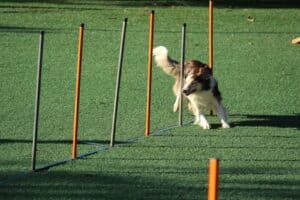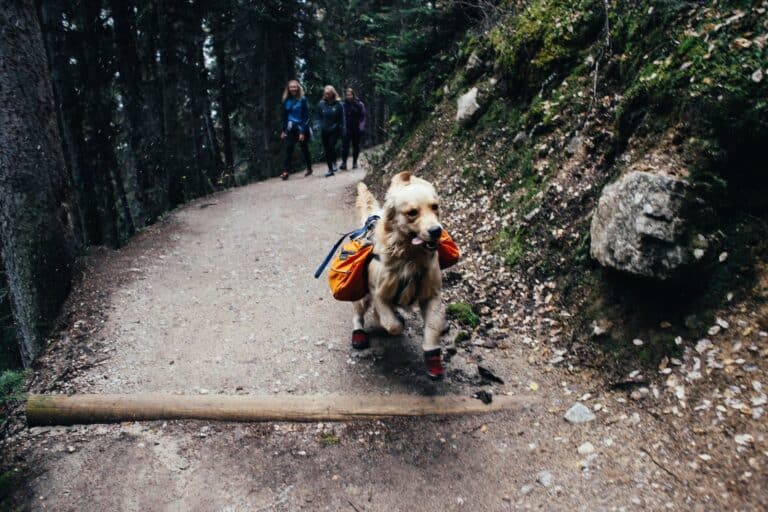Hitting the trails with my furry best friend isn’t just a walk in the park—it’s an adventure that demands preparation and the right gear. Before we dive into the wild, it’s crucial to ensure our canine companions are up for the challenge, both physically and mentally.
Benefits of Trail Running with Dogs
How to Train Your Dog to Run with You
Introducing my dog to trail running was a game-changer. Early in our outdoor adventures, I learned that running with a dog lead is about patience and consistency. To seamlessly integrate your furry companion into your running routine, start with basic leash training. Your dog must learn to run by your side without tugging or lagging. I practiced on neighborhood walks, rewarding my dog for keeping pace. As confidence grew, we progressed from the sidewalks to dog-friendly trails.
Once your dog masters running beside you, maintaining control becomes crucial. It’s essential to invest in the right dog running gear like a bungee leash. This type of leash provides give-and-take between you and your dog, minimizing jolts from sudden stops or sprints. Plus, if you’re navigating technical trails, a close to dog handle allows immediate control over your canine’s movements ensuring pet safety.
Running with My Dog: Safety in Different Ages

Ensuring the safety of your trail-running dog involves considering their age and adhering to trail rules. It’s crucial to determine when it’s appropriate for an off-leash dog to engage in trail running. In general, young dogs should refrain from strenuous runs until their joints fully mature, usually around one year. However, recognizing individual variations is key, and consulting your dog’s vet is advisable. For older dogs, be attentive to signs of fatigue. If they struggle to maintain their usual pace, opt for shorter, more leisurely runs, and carefully monitor their post-exercise responses, following established trail-runner guidelines.
Consistency and Training Tips
Consistency is key to learning how to train my dog to run with me. Regular runs acclimate your pet to the rhythm and rigors of the trail. Begin with short distances, gradually increasing as your dog builds stamina. Incorporating trail run sessions into our weekly routine has significantly enhanced both you and your dog’s endurance.
When jogging with your dog, it’s also about making it enjoyable. Bring along dog snacks for breaks, and ensure your dog is well-hydrated. Trail running with dogs isn’t only about physical exercise; it’s about reinforcing a bond. Through shared experiences on the trail, your dog becomes more than a pet; they’re a trail runner companion.
Considerations Before Trail Running with Dogs
Taking to the trails with a furry friend by your side is one of the great joys of trail running with dogs. But before lacing up and snapping on your dog’s leash, there are essential considerations that every pet owner should be aware of. Planning is crucial; it ensures the safety and enjoyment for both you and your dog.
How to Train Your Dog to Run with You
Training your dog to run alongside you is the foundation for a successful trail run. It begins with basic obedience training, teaching them to follow commands with distractions. I’ve found that consistency and patience are pivotal when I’m introducing the concept of running with a dog lead. Start with short runs in familiar, less challenging environments like your neighborhood, and gradually work up to more complex trail systems.
Running with My Dog: Assessing Fitness and Age
Before embarking on a regular running routine, consider your dog’s age and physical capabilities. What age should dogs stop running? It’s a critical question. Older dogs may not have the stamina for long distances, and it’s important to consult with your dog’s vet before starting any new exercise routine with your pup. Likewise, young dogs’ bones and joints are still developing, so strenuous or extended running could be damaging. It’s best to wait until your vet gives the green light for more intense activity.
Jogging with Your Dog: Gear and Safety
When I’m out trail running, having the right gear is non-negotiable. A bungee leash can reduce strain on both your dog and you, while a proper-fitting harness ensures control without discomfort. Safety gear is also vital; I always ensure my dog wears a GPS dog collar to keep track of their location at all times. This is especially important if you’re running in places where your dog might venture off the path.
Mastering the Trail: Training and Practice
The transition from neighborhood walks to trail running with dogs should be gradual. I start with shorter trails that aren’t too technical to allow my dog to adapt to the varied terrain. As your dog becomes more comfortable, you can start introducing more advanced trails with different challenges like steep inclines, rocky surfaces, and potential trail hazards. Always keep your dog close to handle any spontaneous issues swiftly. Remember, the goal is to make running with your dog an enjoyable and rewarding experience for both of you. It’s not just about the physical exercise but also the mental stimulation that comes from exploring new environments.
Training Your Dog for Trail Running

As a dedicated trail runner, I’ve learned that trail running with dogs is not only a fantastic way to bond but also an incredible workout for both pet and owner. However, just like any skill, teaching how to train your dog to run with you on rugged paths requires patience, consistency, and the right approach.
Preparing Your Pooch for the Trails
Before hitting the dog-friendly trails together, it’s critical to ensure my furry friend is equipped for the journey. That starts with essential dog running gear. I always check that the bungee leash is secure yet provides enough flexibility for those spontaneous squirrel chases. A GPS dog collar also tops the list to help track my dog’s location, ensuring pet safety is never compromised.
Gradual Training is Key
When I first set out to trail run with my canine companion, I didn’t expect it to start running like a seasoned trail runner overnight. Running with a dog lead requires introducing the activity slowly. Depending on the dog’s age and health, a gradual increase in distance and intensity ensures the dog’s stamina and muscles adapt without risking injury. Jogging with your dog on level ground before attempting steep or technical trails is an essential step.
Knowing Your Dog’s Limits
Understanding what age should dogs stop running is a factor I take seriously. Young dogs may have endless energy, but their joints and muscles are still developing, and trail running can be strenuous. On the flip end, older dogs might not match the fervor they once had. A visit to the dog’s vet can provide guidance tailored to my own dog’s needs.
Reinforcing Commands and Trail Etiquette
Running with my dog means reinforcing obedience and commands, crucial for off-leash adventures in approved off leash areas. A well-leashed dog respects other trail users and the environment. Ensuring carry-along poop bags to handle my dog’s waste is not just polite; it’s a responsibility I take as seriously as packing my own snacks.
Build, Endurance, and Safety
The physical dog’s build and breed play a role in how intense our running sessions can be. Breeds accustomed to endurance, like a Border Collie, may thrive on the trail, while others might prefer shorter bursts of activity. It’s crucial to tailor our running routine to suit the specific needs and characteristics of our furry companion. Just like humans, dogs benefit from regular exercise to maintain a healthy weight and overall well-being.
Essential Gear for Trail Running with Dogs

While exploring the trails, the appropriate gear becomes indispensable, benefiting not only the runner but also their four-legged companion. Vital gear for dog owners participating in trail running guarantees the well-being, command, and pleasure of both the owner and their furry friend as they traverse varied landscapes. This equipment plays a pivotal role in safeguarding the dog’s health and maintaining control during the run.
The Right Leash Can Make All the Difference
When it comes to running with a dog lead, I prefer gear that’s designed specifically for the dynamic nature of trail running. A bungee leash is a game changer. It absorbs the shock of sudden movements, making it more comfortable for both me and my dog. Secure yet giving, these leashes reduce strain on both our bodies. The absence of jolting helps maintain our focus and stamina throughout the run.
Waist-Attached Leash for Hands-Free Convenience
A running with a dog lead that attaches to my waist is one of my top picks. It’s essential for maintaining my balance and movement while keeping my hands free. This type of leash typically features a waist belt and can often convert into a handheld option if necessary. Some of my favorites also include compartments for dog snacks and poop bags, adding to their utility. I’ve found that running hands-free allows for a more natural arm swing, which in turn helps with my running form and endurance.
Considering Safety Above All
When running with my dog, their safety is always my priority. I make sure to choose equipment that can endure the ruggedness of the trails, like GPS dog collars. Not only do these collars help keep track of my dog’s location, but they also ensure I’m aware if my dog strays too far. It’s an invaluable tool, especially when dealing with off leash dogs or in approved off leash areas.
As much as I emphasize on gear, knowing how to train my dog to run with me is critical. Consistent training ensures that my dog responds to commands correctly, whether it’s on the leash or off. Communication between us needs to be clear to keep both of us safe from potential trail hazards.
Adapting Gear for Age and Stamina
What age should dogs stop running is a common concern amongst pet owners. It’s vital to adjust not only the intensity of your runs but also the gear you use as your dog ages. Younger dogs could do well with a more robust running routine, but as they mature, it’s crucial to be mindful of their changing stamina and joint health. For older dogs, consider swapping out intense sprints for leisurely jogs to accommodate their energy levels.
Safety Tips for Trail Running With Dogs

When I hit the trails with my furry companion, safety is always my top priority. Running with a dog lead adds an extra layer of security. It’s crucial, however, to know how to train your dog to run with you efficiently. A well-behaved dog on the leash not only ensures your pet’s safety but also enhances the experience for you, your dog, and other trail users.
Pre-Run Training and Gear
Before diving headfirst into trail running with dogs, I’ve learned a few tricks on how to train my dog to run with me. Regular neighborhood walks are a good start. They establish a routine and help my pup understand the basics of leash etiquette. Jogging with your dog on familiar terrain can prepare them for the unpredictable nature of trails.
Essential dog running gear plays a significant role too. Here’s a quick rundown:
- Bungee leash: This helps absorb the shock of sudden movements.
- Running with a dog lead: A waist belt or a close to dog handle are both efficient ways to maintain control without compromising on freedom.
- GPS dog collar: To keep track of my dog’s location, particularly handy if a trail permits off-leash moments.
- Dog snacks and water: Keeping my dog hydrated and energized is a must.
While On the Trail
Once we begin our run, I always keep a few things in mind. Understanding at what age dogs should stop running is important. Puppies and senior dogs may not have the stamina or joint health for prolonged running sessions. I make it a point to get my dog’s vet to weigh in on my dog’s fitness for running, especially for those uphill climbs.
Younger dogs might need a slow introduction to longer distances, and the same goes for dogs who are new to running. Running with my dog on trails came gradually. We started with short distances and progressively built up to more challenging runs.
Lastly, I’ve adopted the practice of running with a dog lead at all times. This prepares us for any surprises that might crop up on the trails, like wildlife or sudden trail hazards.
Being mindful of these tips has not only kept my running with my dog safe but also incredibly rewarding. We both enjoy the stunning scenery and exhilarating experience that trail running with dogs brings.
Key Takeaways
Trail running with my furry friend has been a game-changer for both my fitness routine and my dog’s happiness. With the right preparation and gear, these runs can be safe, enjoyable, and a fantastic way to bond. Remember to always keep your dog’s needs in mind and adjust your plans accordingly. Whether you’re just starting out or you’re seasoned trail runners, the adventure that awaits you both is truly rewarding. Here’s to many more miles of happy trails with your four-legged companion by your side!
